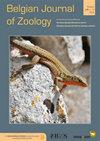波兰白鹳体内寄生虫及相关组织病理学变化
IF 1.1
4区 生物学
Q2 ZOOLOGY
引用次数: 4
摘要
本研究的目的是分析波兰不同地区筑巢地的死白鹳寄生区系及其相关的组织病理学变化。38只年龄在3周至5岁之间的白鹳抵达鹳保护区后,对其样本进行了检查。38名个体中有17名(47.73%)被证实存在先天性Cathaemasia hians、Chaunocephalus ferox、漏斗锥虫、四角Railletina和Syngamus气管。研究区域不存在黑尾丝虫和叉头吸虫。与第二组(11-15周龄)和第三组(2岁以上)相比,第一组(3-4周龄)最年轻的鹳的C.ferox频率明显更高。仅在三个样本(第III组)中用沉淀法检测到流感卵,而在肠道中根本没有发现成年吸虫。与其他寄生虫相比,在所有研究的鹳科动物中,叉头鹳被证明是最常见的病原体。空肠和回肠的组织病理学检查显示,肌肉层发生动脉粥样硬化变化,粘膜中有淋巴浸润,肠腔中有成年的C.hians和C.ferox吸虫,肌肉层有淋巴浸润。在肠道中严重感染四角孢和漏斗锥虫的鹳中,也观察到粘膜中有强烈的淋巴浸润。寄生虫感染会损害鸟类的健康状况,影响飞行时间,还会增加患其他疾病的风险。本文章由计算机程序翻译,如有差异,请以英文原文为准。
Internal parasites and associated histopathological changes in deceased white storks from Poland
The aim of this study was to analyze the parasitic fauna of dead white storks in nesting sites in different parts of Poland and the associated histopathological changes. Samples from thirty-eight white storks aged 3 weeks to 5 years were examined after their arrival at a stork sanctuary. The presence of Cathaemasia hians , Chaunocephalus ferox , Choanotaenia infundibulum , Railletina tetragona and Syngamus trachea was confirmed in 17 out of 38 (47.73 %) individuals. Cathaemasia hians and Chaunocephalus ferox flukes are not endemic to the studied area. The frequency of C. ferox was significantly higher in the youngest storks from group I (3–4 weeks old) compared to groups II (11–15 weeks old) and III (older than 2 years). Fluke eggs were only detected with sedimentation method in three samples (group III), while no adult flukes at all were found in the intestines. Chaunocephalus ferox was shown to be the most common pathogen in all storks studied when compared to other parasites. A histopathological examination of the jejunum and ileum revealed atherosclerotic changes in the muscular layer, lymphoid infiltration in the mucosa, the presence of adult flukes of C. hians and C. ferox in the intestinal lumen, and lymphoid infiltration in the muscular layer. Intense lymphoid infiltration in the mucosa was also observed in storks whose intestines were heavily infested with R. tetragona and C. infundibulum . Parasitic infections compromise the birds’ health status and affect the duration of flights, and they can increase the risk of other diseases.
求助全文
通过发布文献求助,成功后即可免费获取论文全文。
去求助
来源期刊

Belgian Journal of Zoology
生物-动物学
CiteScore
1.90
自引率
0.00%
发文量
10
审稿时长
>12 weeks
期刊介绍:
The Belgian Journal of Zoology is an open access journal publishing high-quality research papers in English that are original, of broad interest and hypothesis-driven. Manuscripts on all aspects of zoology are considered, including anatomy, behaviour, developmental biology, ecology, evolution, genetics, genomics and physiology. Manuscripts on veterinary topics are outside of the journal’s scope. The Belgian Journal of Zoology also welcomes reviews, especially from complex or poorly understood research fields in zoology. The Belgian Journal of Zoology does no longer publish purely taxonomic papers. Surveys and reports on novel or invasive animal species for Belgium are considered only if sufficient new biological or biogeographic information is included.
 求助内容:
求助内容: 应助结果提醒方式:
应助结果提醒方式:


